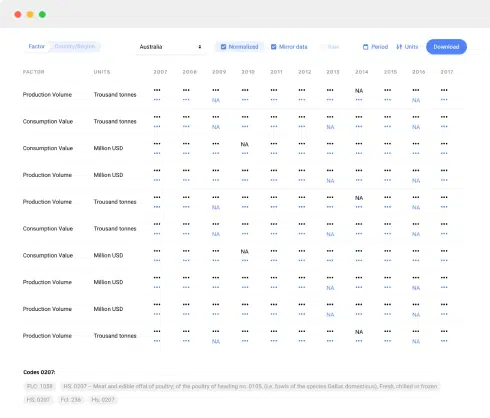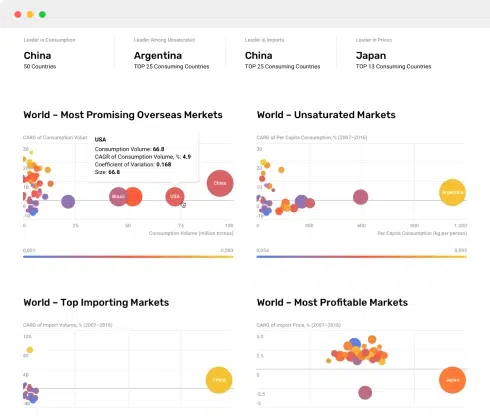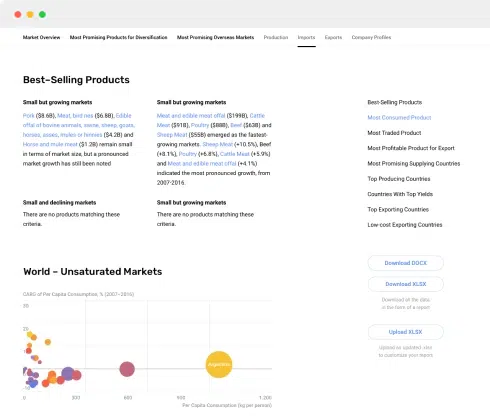
Sennheiser and Sony Dominate Premium Headphones with 4.2+ Ratings, Soundcore Leads Volume at 93K Units
Understanding brand positioning in the competitive headphones market requires a multidimensional analysis of ratings, reviews, pricing, and sales volume. This report leverages IndexBox data to dissect market dynamics, revealing strategic opportunities for brands to optimize their positioning, pricing, and product offerings.
Methodology
The analysis is based on data collected via IndexBox monitoring tools from the Amazon marketplace in the United States, with ZIP code 60007 as the delivery location. The dataset reflects product categories identified by specific search keywords. For detailed brand-level insights, refer to the Brands section of IndexBox.
Rating vs Reviews: Quadrant Analysis
The scatter plot categorizes brands into four quadrants: Star Brands (Sennheiser, JBL, Sony), Rising (JVC, Razer), Niche (Linsoul, Audio-Technica), and Problematic (Jabra, Monster, Plantronics). Star brands combine high ratings (>4.18) and high reviews (>119), indicating strong market trust. Rising brands show potential but need quality improvements. Niche players excel in ratings but lack visibility, while Problematic brands require holistic enhancements in product quality and marketing.
Price vs Sales Volume: Strategic Positioning
Premium brands like Sony and Sennheister achieve high sales at elevated prices ($250+), while budget players (MUSICOZY, Soundcore) dominate volume with aggressive pricing (<$130). Audio-Technica and Jabra struggle with low volume despite premium pricing, suggesting misaligned value propositions. Recommendations include:
- Premium Brands: Expand mid-tier offerings to capture price-sensitive segments.
- Budget Brands: Enhance perceived value through bundling or feature differentiation.
Price Distribution: Segmentation Insights
The histogram reveals a bimodal distribution with peaks at $17–$48 (budget) and $250–$267 (premium). Anomalies include ultra-premium outliers ($1,000+), indicating niche luxury demand. Brands should:
- Segment assortments clearly into budget, mid-range, and premium tiers.
- Leverage KDE trends to identify optimal price points (e.g., $50–$130 for mass appeal).
Market Share: Volume Leadership
Soundcore leads with 18.7% share, followed by TOZO (13.7%) and JBL (12%). The "Others" segment (42.1%) highlights fragmentation. Leaders should:
- Strengthen loyalty programs to retain share.
- Acquire emerging brands in the "Others" segment to consolidate position.
Price Dispersion: Assortment Optimization
Audio-Technica shows the widest price range ($13–$449), while MUSICOZY is tightly clustered ($15–$82). Recommendations:
- Reduce outlier skew (e.g., Audio-Technica's $2,199 offerings) to avoid consumer confusion.
- Align price ranges with brand positioning (e.g., Linsoul's $14–$400 range dilutes premium perception).
Custom Search Request
IndexBox enables on-demand parsing via the Custom Search Request panel or API (POST /api/brand/search). Users can save parameters and track request statuses for real-time market insights.
Conclusion
The headphones market is bifurcated into budget and premium segments, with clear leaders in each. Brands must align pricing, quality, and marketing to their quadrant positioning. Regular monitoring through IndexBox ensures agility in responding to market shifts.
1. INTRODUCTION
Making Data-Driven Decisions to Grow Your Business
- REPORT DESCRIPTION
- RESEARCH METHODOLOGY AND THE AI PLATFORM
- DATA-DRIVEN DECISIONS FOR YOUR BUSINESS
- GLOSSARY AND SPECIFIC TERMS
2. EXECUTIVE SUMMARY
A Quick Overview of Market Performance
- KEY FINDINGS
- MARKET TRENDSThis Chapter is Available Only for the Professional EditionPRO
3. MARKET OVERVIEW
Understanding the Current State of The Market and its Prospects
- MARKET SIZE: HISTORICAL DATA (2012–2024) AND FORECAST (2025–2035)
- MARKET STRUCTURE: HISTORICAL DATA (2012–2024) AND FORECAST (2025–2035)
- TRADE BALANCE: HISTORICAL DATA (2012–2024) AND FORECAST (2025–2035)
- PER CAPITA CONSUMPTION: HISTORICAL DATA (2012–2024) AND FORECAST (2025–2035)
- MARKET FORECAST TO 2035
4. MOST PROMISING PRODUCTS FOR DIVERSIFICATION
Finding New Products to Diversify Your Business
- TOP PRODUCTS TO DIVERSIFY YOUR BUSINESS
- BEST-SELLING PRODUCTS
- MOST CONSUMED PRODUCTS
- MOST TRADED PRODUCTS
- MOST PROFITABLE PRODUCTS FOR EXPORTS
5. MOST PROMISING SUPPLYING COUNTRIES
Choosing the Best Countries to Establish Your Sustainable Supply Chain
- TOP COUNTRIES TO SOURCE YOUR PRODUCT
- TOP PRODUCING COUNTRIES
- TOP EXPORTING COUNTRIES
- LOW-COST EXPORTING COUNTRIES
6. MOST PROMISING OVERSEAS MARKETS
Choosing the Best Countries to Boost Your Export
- TOP OVERSEAS MARKETS FOR EXPORTING YOUR PRODUCT
- TOP CONSUMING MARKETS
- UNSATURATED MARKETS
- TOP IMPORTING MARKETS
- MOST PROFITABLE MARKETS
7. PRODUCTION
The Latest Trends and Insights into The Industry
- PRODUCTION VOLUME AND VALUE: HISTORICAL DATA (2012–2024) AND FORECAST (2025–2035)
8. IMPORTS
The Largest Import Supplying Countries
- IMPORTS: HISTORICAL DATA (2012–2024) AND FORECAST (2025–2035)
- IMPORTS BY COUNTRY: HISTORICAL DATA (2012–2024)
- IMPORT PRICES BY COUNTRY: HISTORICAL DATA (2012–2024)
9. EXPORTS
The Largest Destinations for Exports
- EXPORTS: HISTORICAL DATA (2012–2024) AND FORECAST (2025–2035)
- EXPORTS BY COUNTRY: HISTORICAL DATA (2012–2024)
- EXPORT PRICES BY COUNTRY: HISTORICAL DATA (2012–2024)
10. PROFILES OF MAJOR PRODUCERS
The Largest Producers on The Market and Their Profiles
LIST OF TABLES
- Key Findings In 2024
- Market Volume, In Physical Terms: Historical Data (2012–2024) and Forecast (2025–2035)
- Market Value: Historical Data (2012–2024) and Forecast (2025–2035)
- Per Capita Consumption: Historical Data (2012–2024) and Forecast (2025–2035)
- Imports, In Physical Terms, By Country, 2012–2024
- Imports, In Value Terms, By Country, 2012–2024
- Import Prices, By Country, 2012–2024
- Exports, In Physical Terms, By Country, 2012–2024
- Exports, In Value Terms, By Country, 2012–2024
- Export Prices, By Country, 2012–2024
LIST OF FIGURES
- Market Volume, In Physical Terms: Historical Data (2012–2024) and Forecast (2025–2035)
- Market Value: Historical Data (2012–2024) and Forecast (2025–2035)
- Market Structure – Domestic Supply vs. Imports, in Physical Terms: Historical Data (2012–2024) and Forecast (2025–2035)
- Market Structure – Domestic Supply vs. Imports, in Value Terms: Historical Data (2012–2024) and Forecast (2025–2035)
- Trade Balance, In Physical Terms: Historical Data (2012–2024) and Forecast (2025–2035)
- Trade Balance, In Value Terms: Historical Data (2012–2024) and Forecast (2025–2035)
- Per Capita Consumption: Historical Data (2012–2024) and Forecast (2025–2035)
- Market Volume Forecast to 2035
- Market Value Forecast to 2035
- Market Size and Growth, By Product
- Average Per Capita Consumption, By Product
- Exports and Growth, By Product
- Export Prices and Growth, By Product
- Production Volume and Growth
- Exports and Growth
- Export Prices and Growth
- Market Size and Growth
- Per Capita Consumption
- Imports and Growth
- Import Prices
- Production, In Physical Terms: Historical Data (2012–2024) and Forecast (2025–2035)
- Production, In Value Terms: Historical Data (2012–2024) and Forecast (2025–2035)
- Imports, In Physical Terms: Historical Data (2012–2024) and Forecast (2025–2035)
- Imports, In Value Terms: Historical Data (2012–2024) and Forecast (2025–2035)
- Imports, In Physical Terms, By Country, 2024
- Imports, In Physical Terms, By Country, 2012–2024
- Imports, In Value Terms, By Country, 2012–2024
- Import Prices, By Country, 2012–2024
- Exports, In Physical Terms: Historical Data (2012–2024) and Forecast (2025–2035)
- Exports, In Value Terms: Historical Data (2012–2024) and Forecast (2025–2035)
- Exports, In Physical Terms, By Country, 2024
- Exports, In Physical Terms, By Country, 2012–2024
- Exports, In Value Terms, By Country, 2012–2024
- Export Prices, By Country, 2012–2024


